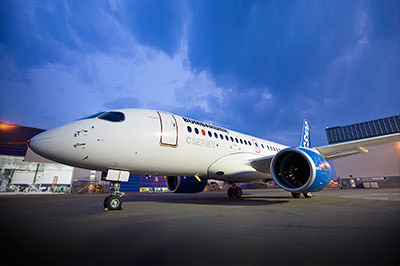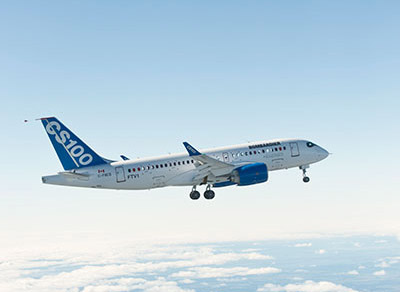
Features
Aircraft manufacturers
The Sky’s the Limit for CSERIES
Now comes the hard part. With its first flight out of the way, Bombardier needs to beef up the order book for its CSeries, which sat at a meagre 177 firm orders at the time of its first flight on Oct. 16
November 14, 2013 By Brian Dunn
Now comes the hard part. With its first flight out of the way, Bombardier needs to beef up the order book for its CSeries, which sat at a meagre 177 firm orders at the time of its first flight on Oct. 16, far short of Bombardier’s goal of 300 by the time the aircraft is scheduled to enter service either next year or in 2015.
 |
|
| The CSeries is the world’s first all-new aircraft the 100- to 160-seat class in almost 50 years. PHOTO: BOMBARDIER
|
And it won’t be easy. While Bombardier is banging up against the smaller aircraft of Airbus and Boeing, Embraer is nipping at its heels as the Brazilian company joins the challenge to the two dominant players in the 100- to 160-seat market. The CS100 will seat 110 in a typical configuration, while the larger CS300 will seat between 135 and 160, depending on configuration.
There’s also the Russian-built 100-seat Sukhoi Superjet, the Mitsubishi 70- to 90-seat Regional Jet and China’s 90-seat ARJ 21 and larger C919 to consider, although that program is facing delays. However, the Sukhoi has its own problems after one of its aircraft crashed in Indonesia last year during a promotional flight in which 45 people were killed. And in July, one of its planes made a belly landing during a test flight at Iceland’s Keflavik airport in Reykjavik, according to a statement by its Russian manufacturer.
Bombardier did get a bit of good news on Sept. 26, when president Rusdi Kirana of Indonesian airline Lion Air said his carrier will launch Bombardier’s CS300 with a major purchase he expects to finalize at the Farnborough air show next July.
The CSeries is the world’s first all-new plane in the 100- to 150-seat class in almost 50 years, when the McDonnell-Douglas DC-9 (initially know as Douglas DC-9) had its maiden voyage in 1965 with the last one being delivered in 1982. The CSeries100 is also the first all-new single-aisle aircraft since 1987, when Airbus first flew its A320.
It’s been a tough slog for Bombardier, which first announced the CSeries in 2004, but after investing US$100 million in development, it failed to sign up customers and shelved the project in 2006. It kept the concept alive with US$20 million in annual funding and a skeleton crew and restarted the project in 2008 after Lufthansa signed a letter of interest for 30 firm orders and 30 options.
The CSeries will use two Pratt & Whitney PurePower PW1500G turbofans and have a range of 2,950 nautical miles. It is 5,400 kilograms lighter than other aircraft in the same seat category and is expected to burn 20 per cent less fuel than current models on the market.
Embraer says it will offer new versions of larger E-Jets by the end of the decade. Its E175, E190 and E195 jets will offer new, more fuel-efficient engines, the same power plants available on the CSeries and more modern wings that will help reduce fuel consumption, noise, emissions and maintenance costs.
The E175-E2 will offer an additional row of seats to carry 88 passengers, while the E195-E2 will add three rows of seats that will enable it to carry 132 travellers. That’s the heart of the single-aisle segment targeted by the CSeries.
Embraer already has orders, options and letters of intent for 365 aircraft. That includes 100 firm orders and 100 options from SkyWest that could be worth as much as US$9.3-billion. In addition, Embraer landed 25 firm orders for the E195-E2 from International Lease Finance Corp., a leasing company that so far has not ordered any CSeries aircraft.
 |
|
| The CSeries uses two Pratt & Whitney PurePower PW1500G turbofans and has a range of 2,950 nautical miles. The recent successful launch of the aircraft bodes well for its position in the market. PHOTO: BOMBARDIER
|
On the plus side, the CSeries is scheduled to enter service next year, five years ahead of the new Embraer plane. That gives Bombardier plenty of time to improve the plane and benefit from efficiencies Pratt & Whitney will make to the engines.
Credit rating firm Moody’s said the CSeries’ first flight was a positive step towards getting the aircraft into service. “The success of first flight could give potential clients the necessary confidence to place an order,” said Darren Kirk in an analyst note. He added the success of the CSeries program is a key element to enable Bombardier to improve cash flow and reduce its debt.
Still, nothing is written in stone, according to Robert Kokonis, president of Toronto-based aviation consulting firm AirTrav. He alluded to a potential CSeries order at the Farnborough Air Show two years ago from Qatar Airways that never materialized.
“At the end of the day, airlines are watching and waiting. Test flights are important to get real data, but they’re no substitute for the daily grind of operating an aircraft for 10 to 12 hours a day. It’s not just a new airframe but a new powerplant as well.”
Another problem is that the E-2 platform got a lot of traction at the Paris Air Show in June while Bombardier didn’t, Kokonis added. He said reaching the 300 order target set by Bombardier will be a challenge. “Potential customers are looking at a totally new aircraft and new engine and nobody wants to be first, because they’re not certain what the aircraft is capable of doing.”
A more bullish assessment comes from analyst Rick Erickson of R.P. Erickson & Associates of Calgary who thinks the CSeries in a winner. “I think the economies of the aircraft are better than expected and it caught the media by surprise (during first flight) at how quiet the aircraft is,” he said. “Some missed the takeoff completely because it was so quiet. I’ve been in a mock-up of the CSeries and it’s very spacious and it will introduce a new genre of comfort to the market.”
The minor delays of getting it into service shouldn’t be a cause for concern, compared to the much longer delays faced by both the Airbus A380 and the Boeing 787 Dreamliner, the latter which was grounded for months with electrical problems and has made some airlines “gun shy,” said Erickson.
But there are other challenges to overcome: namely that Boeing and Airbus will fight hard against the “newcomer” to protect their market share, and the target markets for the CSeries are Europe and North America which are still in a recessionary mode, forcing airlines to be “very cautious in placing orders,” Erickson added. “But the 20 per cent fuel savings will help them. “Customers are sitting on the fence. By the time it goes into service, you’ll see the order book increase. I expect it will attract a lot more attention at Farnborough next year,” Erickson said.
But it will be important for the CSeries’ success to garner an order from Air Canada, even if it’s a small one, according to Erickson. Porter Airlines also is a potential customer if they get the go-ahead to extend the runway at Billy Bishop Toronto City Airport.
“It was a real coup for Embraer to sell aircraft to Air Canada a few years ago, but there was nothing similar on the market at the time,” Erickson said. “Now that has changed. A lot of airlines around the world watch what Air Canada does as it’s considered a major carrier. So it will be important for Bombardier’s image to secure an order from them.”
While Bombardier has been concentrating on the CSeries, Embraer appears to be gaining market share in the regional jet market at the expense of its Canadian rival. Derek Spronck of RBC Capital Markets wrote in a report that Embraer could increase its regional aircraft market share worldwide from the current 54 per cent to 63 per cent, or nearly two-thirds of the market, in the next three years. Spronck says Bombardier’s deliveries of planes in the 30- to 120-seat segment will fall to 31 per cent over the next three years, from 45 per cent achieved over the past 12 years.
“Embraer has developed successful aircraft platforms with the introduction of new technology while focusing on lowered acquisition prices from the reduction in direct operating costs and improved product reliability. Since 2004, Embraer has steadily eroded Bombardier’s market share dominance in the regional jet space,” Spronck noted, reaching a 76 per cent market share in the year 2012 and an aggregate of 54 per cent in the past 12 years.
“With an entrenched installed base of over 1,800 units and over 60 customers, coupled with the formal announcement of a revamped regional jet family set to launch in 2018, we see Embraer increasing its market share over the next three years to 63 per cent from . . . 54 per cent.”
Spronck noted that regional carriers are shifting from smaller jets to larger aircraft in the U.S. due to concessions from pilots’ unions whose contracts restricted the number and size of small jets the airline could fly to a maximum of 50 seats. As these carriers start replacing their older fleets, Embraer has a clear edge, said Spronck, both with its existing fleet of jets that are newer than Bombardier’s CRJ lineup, as well as its E2 lineup.
Embraer is a significant competitor to Bombardier in the RJ market and has been chipping away its market share, agreed Erickson, who said he wouldn’t be surprised if Bombardier eventually dropped out of that segment of the market, but kept its Q400 program going.
“Bombardier’s RJ program is getting long in the tooth and the CSeries offers a lot more potential,” Spronck said. “At what point do they shut assembly down of the RJ and turn it over to the CSeries program?”
It promises to be a spirited battle for the skies in the 100- to 160-seat class going forward.